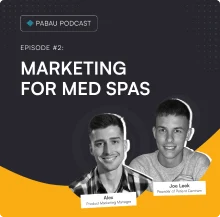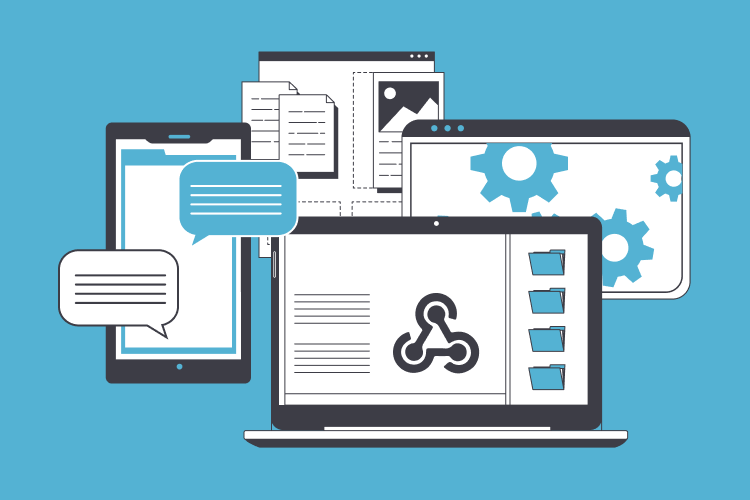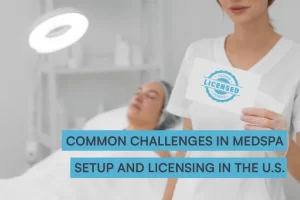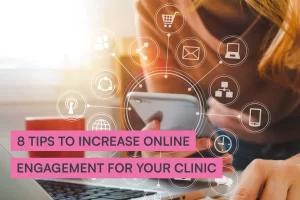Real-time communication between different systems is essential in any busy medical practice.
Consider payments, for instance. If your practice uses management software and an invoice analysis system on the side, you’ll need to update all payment information in both systems, at the same time. Why? Because getting this real-time data helps practices scale, reduce manual admin work, and boost both communication and patient satisfaction.
Not synchronizing payment updates across applications can cause serious issues for your business. Delayed or overlooked payment data, inaccurate invoice analysis, and inconsistent payment reports are some of the challenges you might face as a result.
And it’s not just invoices that can cause issues:
Not updating real-time data across multiple systems can also create havoc in your bookings, leads, and client data. Having systems that speak to each other is essential, otherwise, it could result in things like:
- Missed patient appointments and scheduling conflicts
- Delayed patient communication and team collaboration
- Incomplete patient records and poor quality of care
- Inefficient administration and increased workload
- Lost revenue opportunities
- Inefficient staff workflow
- Patient satisfaction issues
But, here’s the truth — there’s a tool you can use to ensure you always have access to real-time data — webhooks for medical practices.

But there’s no need for confusion — we’ll take you through the nitty-gritty with some TLC.
Read on as we dive into what webhooks are, how they can benefit your practice, and how you can use them to optimize patient engagement. We’ll also include practical examples of using webhooks, and share how beauty experts use webhooks to boost efficiency and overall practice management.
What are webhooks?
That’s the million-dollar question.
Essentially, webhooks are automated messages that are sent in real-time, from one application to another, whenever a specific event, like a new booking, occurs.
Webhooks are used in all sorts of businesses. But they help medical practices, aesthetics clinics, medi-spas, and beauty salons transfer data, such as client information, across any third-party applications they use. Some of these apps might include independent health analytics platforms, prescription management systems, or pharmacy systems.
If your clinic uses practice management software, webhooks will help you source out real-time data, like a new payment, from that software. The data will automatically transfer across any third parties your practice uses, such as bookkeeping apps. And vice versa, when there’s a new information update in, say, your patient portal, webhooks will update instantly and deliver this data to your software.
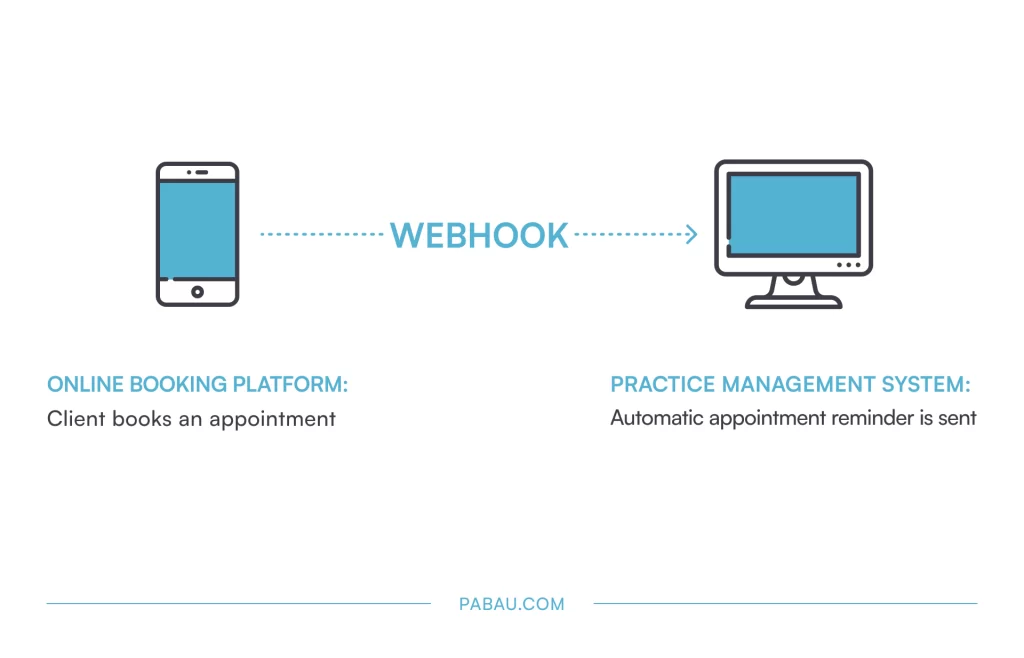
You can think of webhooks as tools that can help different applications ‘talk’ with each other and send real-time data when a specific event is triggered. For your practice, that means more efficiency and automation, and less old-school data handling and manual updating.
Webhooks vs. API — what they do, what’s the difference
If you’ve already heard of webhooks and you’re curious about how to use them in your business, then you might also have come across APIs. As a medical practice with a running website and software, you may use both API and webhooks to handle data.
But there’s a difference in how APIs vs webhooks approach and handle this data.
- APIs are Application Programming Interfaces. They mainly allow different software applications to communicate with each other — upon request.
- Webhooks, on the other hand, help one system automatically notify another system about real-time events, rather than waiting for the second system to request this information.
As a practice, you may use an API to request patient booking data. But you would use webhooks to automatically notify third-party apps about a new event, like a new booking — without needing a request first.
When it comes to boosting the efficiency within your practice, consider that webhooks work smarter, APIs work harder, but both go hand in hand.
How webhooks can assist care providers
Webhooks are quite popular across many industries, like eCommerce. But, healthcare and beauty businesses can largely benefit from them, too.
They’re handy for any size of medi-aesthetics practice, really. However, they add the most value in larger practices that handle a great volume of data and need to —
- Enhance internal collaboration and communication with patients
- Boost practice management efficiency and responsiveness
- Improve patient experiences and engagement
- Track internal events with accuracy and efficiency
Webhooks work wonders for medical practices but can be hard to grasp. So let’s start with an easy example of how webhooks can actually work within your business.
Let’s say that a patient updates their medical information through your website. If you are using webhooks, they will instantly update this change into your practice’s internal system and every other system that might handle this information.
With a real-time update like this, your team can have the latest patient medical data during consultations and treatments. At the same time, practitioners can enhance the quality of care they deliver, while minimizing the risk of outdated records.
Where webhooks can come in handy — practical examples
For medical spas and practices, webhooks can source real-time data for appointments, activities, patients, leads, or invoices. Here’s what that means and how it might work.
1. Appointment reminders
Scenario: A new appointment has been scheduled in your practice’s scheduling system.
What a webhook does: The scheduling system will send a webhook to the messaging service you use, triggering the delivery of an automated appointment reminder to the patient via SMS or email.
2. Electronic Health Record (EHR) updates
Scenario: A patient’s health record has been updated in the EHR system.
What a webhook does: The information will be also updated in your patient portal or any third-party analytics system you use, ensuring both have the most current data.
3. Billing and payment notifications
Scenario: A patient payment has been made in the billing system.
What a webhook does: A webhook will trigger an update of the payment change in your system, and will also notify the patient of this change via email.
4. Prescription refill requests
Scenario: A patient has requested a prescription refill through a patient portal.
What a webhook does: A webhook will update the request in your medical software, alerting care providers that prescriptions need to be renewed.
Likewise, you can use webhooks to engage or convert leads, manage lab results, speed up bookings, and track activities. And here are the benefits of doing just that.
Using webhooks for medical practices: 6 amazing benefits
Webhooks for medical practices can be highly versatile, and so are their advantages.
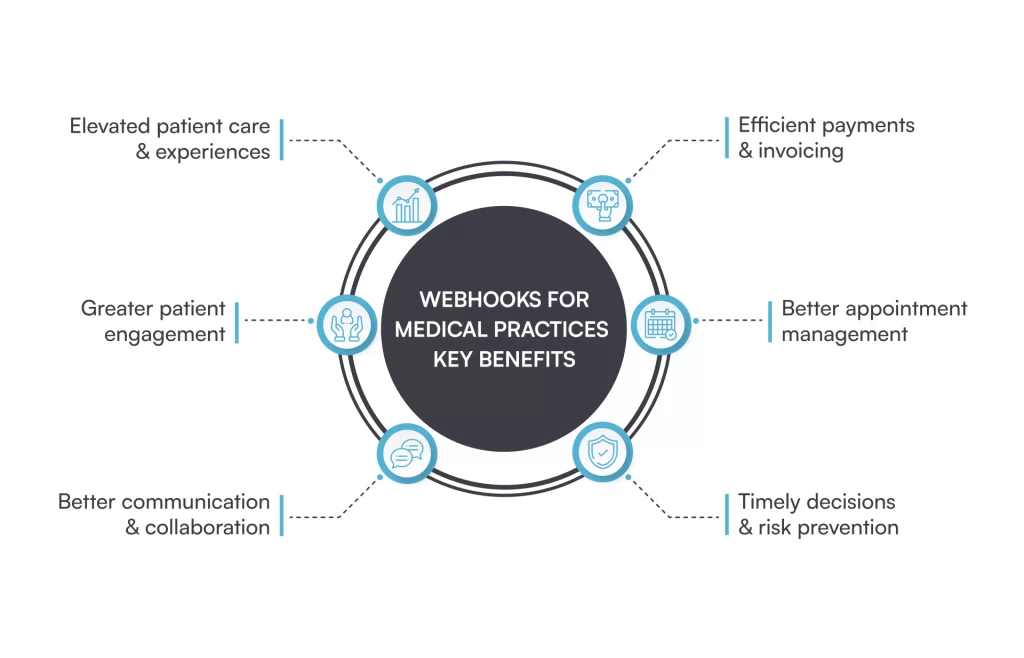
1. Optimize patient care & patient experiences
Webhooks provide your practice with valuable real-time notifications that you can use to optimize patient care and appointment attendance. They help you respond to certain events faster, which optimizes the user experience and prevents data transfer delays.
For example, if a healthcare provider updates a patient’s prescription, a webhook will notify any pharmacy system you use instantly. This helps stock up on meds faster and saves you time on manual updates.
Similarly, webhooks can be used when a patient’s lab results are in — they will simultaneously alert your patient portal, allowing prompt access to results.
The use of webhooks in these scenarios optimizes data sharing and enhances the efficiency of managing prescriptions and accessing lab results. Ultimately, this improves the overall patient treatment and efficiency.
Real-time data is a time-saver — and webhooks help you manage payments, appointments, clients, and leads, whilst making proactive decisions regarding a patient’s well-being. You can optimize the patient experience and provide better and more accurate care — with one striking feature.
2. Ensure efficient invoicing
Webhooks also play a crucial role in streamlining payments for clinics and patients.
Let’s say a patient makes a payment through an online portal. A webhook will trigger an invoice notification to the clinic’s billing system, and other systems that collect this data. The invoice will be promptly recorded, with its status — refunded, voided, updated, etc. You can also send the patient an automated notification, confirming their payment.
For your practice, this means better insights into unpaid invoices, which you can then use for sending invoice reminders and collecting payments faster. Overall, webhooks enhance your financial processes, steady your revenue cycle, and instantly inform patients of how much they have paid, how, and when.
3. Manage patient appointments better
Among other perks, webhooks also give your practice greater control over booked appointments. They send real-time updates whenever a patient’s booking is updated. You can immediately act on that update, and send patients booking reminders, as well as medical forms they need to complete ahead of their visit.
A patient might update their booking by adding a photo, and webhooks will immediately send this to all relevant applications. You can use this data to take action — send the patient details on their progress, or offer additional aftercare if needed.
The same goes for canceled bookings. If a patient cancels their appointment, webhooks will be triggered to take the action that you predefined for this event earlier. The action in this case might be, say, for the system to send a rescheduling link to the patient after their booking was canceled.
Whether your patients create, cancel, or update their bookings, webhooks will keep you in the loop and deliver accurate data upon which you can take action. Sweet, right?
4. Make timely decisions and prevent risks
Real-time data helps notify care providers of critical events. In turn, they can make timely decisions and do damage control where and if needed.
Let’s say that you are a medi-aesthetics practice that offers surgery services for patients. Initially, you can send a post-op survey to these patients so they can score their progress post-surgery.
Now, you can set up webhooks to be triggered by unfavorable survey results. This will help you provide medical assistance to patients who need it. Use the survey data to send an SMS to the patient asking them to attach a photo of their wounds, for a quick check-up by their surgeon.
Because webhooks feed your practice with real-time patient data, your practice will be able to scale on various levels. You’ll boost the speed and efficiency of all interventions. You’ll also speed up your after-care protocols and risk prevention. And with it, you’ll ultimately improve patient outcomes and boost their satisfaction.
5. Improve communication and collaboration
Webhooks eliminate the need for manual real-time data entry. This not only saves your team hours of work and clicking, but it also reduces errors that can be easily caused by miscommunication. Plus, it keeps your team happy, knowing they don’t have to manually update new data ever again.
Let’s say a patient’s medical records have been updated in your software. Instead of your practitioners or admins having to inform every application and person of this change, a webhook can instantly relay this change to relevant third-party applications.
Or, say you have a nurse who has updated a patient’s medication in the system. A webhook will instantly notify the prescribing practitioner and all relevant apps, like your meds supplier, of this update, so they can take action if needed.
An automated approach does your practice good. It eliminates communication delays and streamlines collaboration. Plus, it enables more efficient patient care and less tress for employees.
6. Enhance patient engagement
Webhooks are not only a one-way street, where real-time data is updated across several applications, and that’s it. They can also easily help you engage patients faster.
To give you an idea, let’s say that a patient schedules an appointment with your practice online. Here, a webhook will update this information in your practice’s scheduling system. Then, you can immediately take action and send patients who booked a new appointment health or consent forms, which they’ll immediately receive via email or text.
Webhooks also use HTTPS protocol. This protocol offers a secure way of browsing the internet and ensures that all data that’s exchanged between your web browser and other websites is protected.
If a patient updates their contact information, a webhook can apply the change in your software. This optimizes the way you use the HTTPS protocol and allows for smooth, safer, and more efficient data transfer.
Webhooks for medical practices — security tips to consider
Since webhooks transfer real-time data, ensuring this process is secure is essential in maintaining viable webhooks. Have a look at some of the steps you can take to secure webhooks better —
- Use HTTPS and encryption to secure the webhook communication and protect the data from unauthorized access. To achieve HTTPS security, you have to obtain an SSL/TLS certificate and configure your web server to use HTTPS. As for encryption, check out some of the best security software tools can do for your practice.
- Use retries and tests to ensure the webhooks are delivered and processed accurately. For example, you can book a test appointment as a patient at your practice and see if you receive a reminder via email or text.
- Use filters to specify the events and data that you want to send and receive, like a ‘new appointment created’ filter, to avoid sending unneeded or sensitive data.
- Use logs and monitoring to track and analyze the webhook activity and performance, and identify and address any potential issues.
- Use medical software that supports HIPAA compliance to ensure that any sensitive data that webhooks send to other apps is secure, protected, and breach-proof.
What beauty experts say about webhooks —

Natasha Gordana-Murray
Founder of EQlibrium
👉 Natasha Gordana-Murray is the founder of the EQlibrium clinic, an advanced aesthetics practitioner, a PDO thread specialist, and a former athlete with 15 years of experience. She initially opened EQlibrium to treat chronic pain, injuries, autoimmune diseases, and sports injuries, but later added aesthetics and injectables to her services.
Throughout her career, Natasha has been actively using webhooks and understands their im portance in the health and beauty industry. She briefly explains what webhooks are and shares how beauty practices can use them:
‘Webhooks are essentially messages that are sent by one application when something happens. They act as a signal between various apps, alerting different systems when required. In beauty clinics, for example, webhooks alert a system when a client buys a product online or books an appointment.
For aesthetic clinics, webhooks can make day-to-day processes go smoother. They can help update records almost instantly.
For instance, if a customer purchases a serum online, the clinic’s inventory will get updated immediately, without the need for someone to do it manually. Webhooks work hand in hand with automation by triggering actions when specific events occur, like bookings, and purchases, sending reminders for follow-up appointments, or refills.
It’s important to note that webhooks themselves aren’t precisely like automation; they’re more like the behind-the-scenes messengers that make automation possible.
As for HIPAA (the Health Insurance Portability and Accountability Act), clinics need to be careful when using webhooks. They often handle sensitive info, so must be set up securely to comply with HIPAA rules. In other words, confidential patient data must remain safe.’
Webhooks for medical practices — the verdict
Webhooks are a medical clinic’s lifeline. They help you automate appointment reminders, sync patient records seamlessly, and eliminate paperwork headaches while at it.
Forget juggling between systems, and losing precious information due to delays. Webhooks offer maximum efficiency, whilst leaving quality patient care in your hands.
- The first step on your webhook journey is to assess what your practice needs ‘web-hooked’ — be it appointments, leads, patients, or invoices.
- Next up, consider using clinic management software that supports webhooks. It’s both faster and can save your developers from spending hours setting up webhooks from scratch.
Enter Pabau, your all-in-one practice management software that also supports your business with webhooks. We help you cut down setup time, track and edit webhooks, and ensure all-around efficiency. Smarter practice management — here we come!
